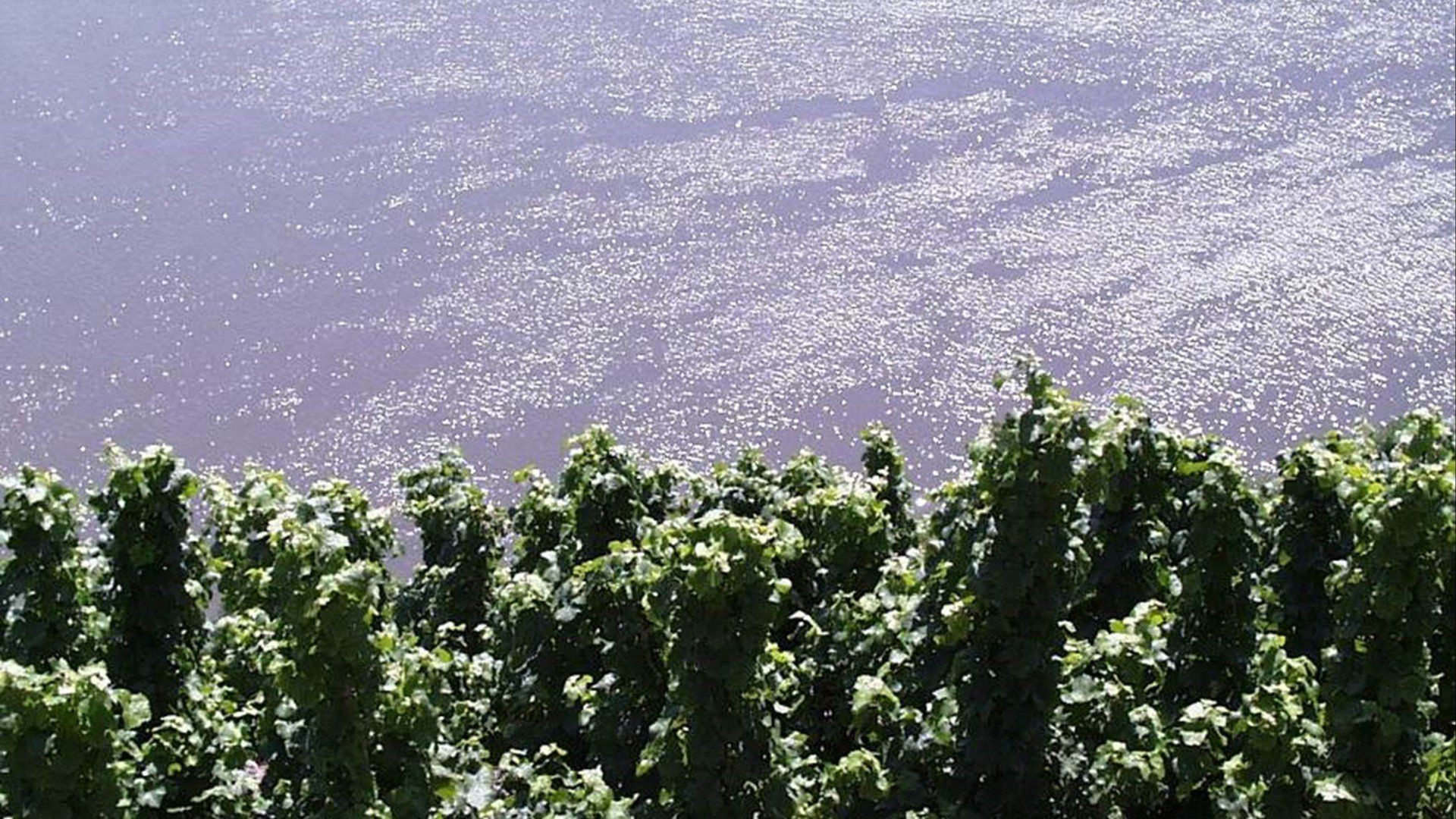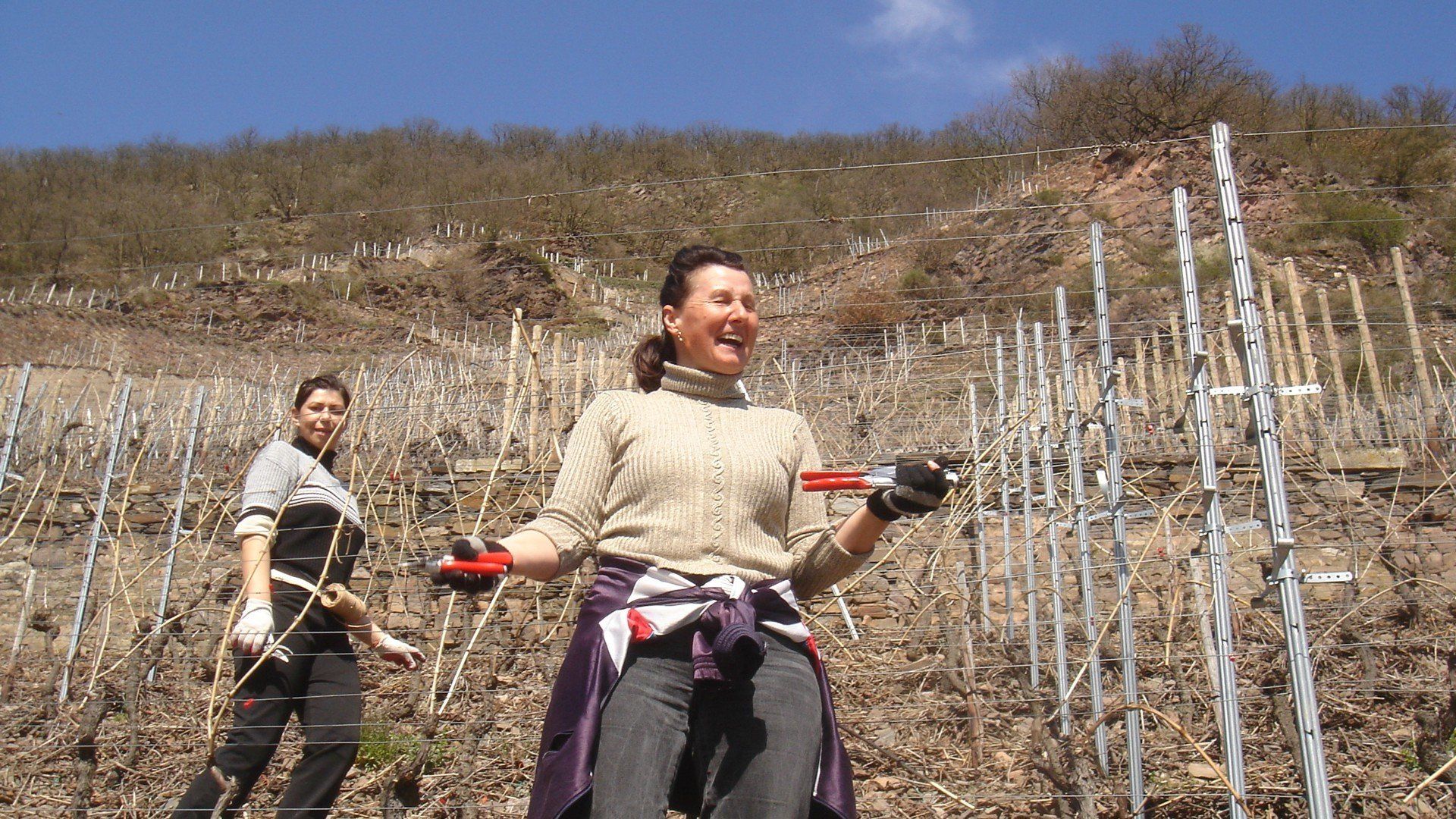
Image title
Untertitel hier einfügenButton
Image title
Untertitel hier einfügenButton
Image title
Untertitel hier einfügenButton
Image title
Untertitel hier einfügenButton
Image title
Untertitel hier einfügenButton
Image title
Untertitel hier einfügenButton
Image title
Untertitel hier einfügenButton
Image title
Untertitel hier einfügenButton
Single pole or wire frame?
the times, they are a'changin
Viele gute Gründe, warum wir die Tradition Tradition sein lassen und unsere Reben an Spalieren wachsen.
Erosion. The grief lying in the vineyard always wanders downhill very quickly when working in the fall line and has to - should - be collected again very time-consuming and distributed in the upper terraces. The grief protects against erosion, suppresses weeds, protects against evaporation and guarantees a better crust.
Ease of work. Working up and down the mountain is very tiring. Horizontally it is still exhausting but okay. And over the years an (almost) comfortable micro-terrace forms in the row. The pruning is more complex because the vines get entangled in the wire. But on the other hand, summer work is done twice as quickly by hand if you don't have to think about each shoot - as with the single stake - whether it should be shortened or not, but can simply plug it into the wire frame. And finally, during the grape harvest, we can walk through the vineyard several times to read selectively. In the case of closely spaced individual stake training, everything must be read in one go in order to avoid major damage to the field.
Botrytis. If it comes at the right time and all in all there is not too much of it, we are happy to sort until late into the evening and press high-quality selections. But…. Usually it comes too early or too late and then the grapes are just plain rotten. Since we do not inject fungicides against the fungus, we rely on phytohygiene in the fight: The grapes should be well ventilated and hang loosely so that the fungus does not even feel comfortable. With a southerly slope, the winds coming from the west can dry the grapes in a very short time with horizontal rows. Then the next big advantage of the wire frame: In contrast to single pole training, there are so many leaves that the pigeon zone can be defoliated without affecting the leaf surface.
Assimilation surface. Through skilful “leave management” we succeed in positively influencing the quality of the grapes. Both the early defoliation of the grape zone and the late shortening of the shoots make the berries smaller and the grapes looser. But be careful: When defoliation, it is essential to ensure that the grapes are not exposed to the sun, so that the dreaded
Cannot develop petroleum taste. Grapes that are too exposed to the sun defend themselves against the UV radiation by developing a pro-carotenoid. And this can later become noticeable in the wine as an unpleasant petrol taste. Here, too, the horizontal trellis training helps us: With the southern orientation of the vineyards, the foliage wall of the lower row throws sufficient shade to protect the grapes of the upper row from the sun or Protect stress. But only if the line spacing is small enough and there are enough vines in the vineyard. That brings us to the last aspect, the
Plant density. Time and again, “low yields of only 50 hl / ha” are advertised in the wine scene. 5000 liters of wine per hectare. But what is normally kept secret: How many vines are there per hectare of vineyard? In practice, the number varies between 1,200 and over 12,000. When talking about quality, and especially when talking about terroir, the crucial question is: What is the root-fruit ratio? How many liters of wine does a vine provide? We have about 0.5 liters per vine - and we are very satisfied with that. A narrow planting of 10,000 plants is of course also possible with a single stake - our grandparents often had even more. But they knew neither sunburn, nor petroleum taste and botrytis - unfortunately all too often unripe grapes. Fortunately, due to climate change, we no longer have any problems with grape ripening - but if we want to continue to press filigree wines, we have to adapt the upbringing of the vines to the new framework conditions.
From a different perspective:
Fits to:
Cool Climate
Delicate feminism
Video with Kathrin Höhler
Single pole or wire frame?
the times, they are a'changin
Viele gute Gründe, warum wir die Tradition Tradition sein lassen und unsere Reben an Spalieren wachsen lassen.
Erosion. The grief lying in the vineyard always wanders downhill very quickly when working in the fall line and has to - should - be collected again very time-consuming and distributed in the upper terraces. The grief protects against erosion, suppresses weeds, protects against evaporation and guarantees a better crust.
Ease of work. Working up and down the mountain is very tiring. Horizontally it is still exhausting but okay. And over the years an (almost) comfortable micro-terrace forms in the row. The pruning is more complex because the vines get entangled in the wire. But on the other hand, summer work is done twice as quickly by hand if you don't have to think about each shoot - as with the single stake - whether it should be shortened or not, but can simply plug it into the wire frame. And finally, during the grape harvest, we can walk through the vineyard several times to read selectively. In the case of closely spaced individual stake training, everything must be read in one go in order to avoid major damage to the field.
Botrytis. If it comes at the right time and all in all there is not too much of it, we are happy to sort until late into the evening and press high-quality selections. But…. Usually it comes too early or too late and then the grapes are just plain rotten. Since we do not inject fungicides against the fungus, we rely on phytohygiene in the fight: The grapes should be well ventilated and hang loosely so that the fungus does not even feel comfortable. With a southerly slope, the winds coming from the west can dry the grapes in a very short time with horizontal rows. Then the next big advantage of the wire frame: In contrast to single pole training, there are so many leaves that the pigeon zone can be defoliated without affecting the leaf surface.
Assimilation surface. Through skilful “leave management” we succeed in positively influencing the quality of the grapes. Both the early defoliation of the grape zone and the late shortening of the shoots make the berries smaller and the grapes looser. But be careful: When defoliation, it is essential to ensure that the grapes are not exposed to the sun, so that the dreaded
Cannot develop petroleum taste. Grapes that are too exposed to the sun defend themselves against the UV radiation by developing a pro-carotenoid. And this can later become noticeable in the wine as an unpleasant petrol taste. Here, too, the horizontal trellis training helps us: With the southern orientation of the vineyards, the foliage wall of the lower row throws sufficient shade to protect the grapes of the upper row from the sun or Protect stress. But only if the line spacing is small enough and there are enough vines in the vineyard. That brings us to the last aspect, the
Plant density. Time and again, “low yields of only 50 hl / ha” are advertised in the wine scene. 5000 liters of wine per hectare. But what is normally kept secret: How many vines are there per hectare of vineyard? In practice, the number varies between 1,200 and over 12,000. When talking about quality, and especially when talking about terroir, the crucial question is: What is the root-fruit ratio? How many liters of wine does a vine provide? We have about 0.5 liters per vine - and we are very satisfied with that. A narrow planting of 10,000 plants is of course also possible with a single stake - our grandparents often had even more. But they knew neither sunburn, nor petroleum taste and botrytis - unfortunately all too often unripe grapes. Fortunately, due to climate change, we no longer have any problems with grape ripening - but if we want to continue to press filigree wines, we have to adapt the upbringing of the vines to the new framework conditions.
From a different perspective:
Fits to:
really cool, the climate






